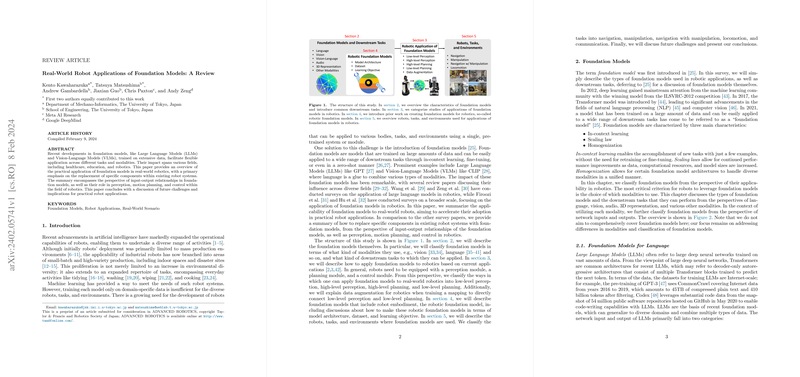Overview of Real-World Robot Applications of Foundation Models
In the rapidly evolving field of robotics, the integration of foundation models including LLMs and Vision-LLMs (VLMs) holds the potential to significantly advance the versatility and efficiency of robotic systems. This paper provides a comprehensive review of the current state and future directions of employing foundation models in real-world robotics. The focus is on how these models, trained on extensive datasets, can replace specific components within robot systems, enhancing their ability to understand and interact with their environments in more sophisticated ways.
Foundation Models in Robotics
Foundation models, characterized by their in-context learning ability, scaling laws, and homogenization, offer a promising avenue for the development of more general and adaptable robotic systems. These models, including notable examples like GPT and CLIP, are trained on vast amounts of data, enabling them to apply learned knowledge to a wide range of downstream tasks with minimal additional training.
The classification of foundation models from a robotics perspective is pivotal. The choice of modalities—such as language, vision, audio, and 3D representation—plays a crucial role in determining the suitability of foundation models for specific robotic applications. Furthermore, the paper explores various types of foundation models and their applicability in robotics, encompassing tasks from high-level planning to low-level perception and control.
Application of Foundation Models to Robotics
The paper categorizes the application of foundation models into five key areas: low-level perception, high-level perception, high-level planning, low-level planning, and data augmentation. Each category serves a distinct purpose, from feature extraction and scene recognition to the generation of task plans and motion control strategies. Notably, the integration of foundation models facilitates a novel approach to robotics, enabling systems to perform complex tasks with greater autonomy and adaptability.
Among the discussed applications, several innovative methods stand out. For example, the use of LLMs for generating task planning and code generation allows for more flexible and context-aware robot behavior. Similarly, the development of VLMs for high-level perception enables robots to better understand and navigate their environments.
Towards Robotic Foundation Models
The concept of robotic foundation models represents a frontier in robotics research. These models aim to encompass a broader range of capabilities, from perception to action, within a single framework. The paper highlights the challenges associated with building such comprehensive models, including data collection and the need for architectures capable of handling diverse modalities and tasks. Despite these challenges, the potential benefits of robotic foundation models—such as increased generalization and efficiency—are profound.
Future Directions and Challenges
Looking ahead, the paper identifies several key areas for future research. These include the expansion of modalities utilized by foundation models, the refinement of skill granularity within robotic systems, and the generalization of robots to operate in a wider variety of environments and tasks. Additionally, the paper acknowledges the need for robust evaluation methodologies to assess the performance of robots powered by foundation models in real-world scenarios.
Conclusion
The integration of foundation models into robotics offers a path toward more intelligent, adaptable, and capable robotic systems. By leveraging the vast knowledge encoded in these models, robots can achieve a higher level of understanding and interaction with their surroundings. The ongoing development of robotic foundation models promises to further accelerate advances in the field, paving the way for robots that are not only practical for a wide range of applications but also more akin to their human counterparts in adaptability and ingenuity.
